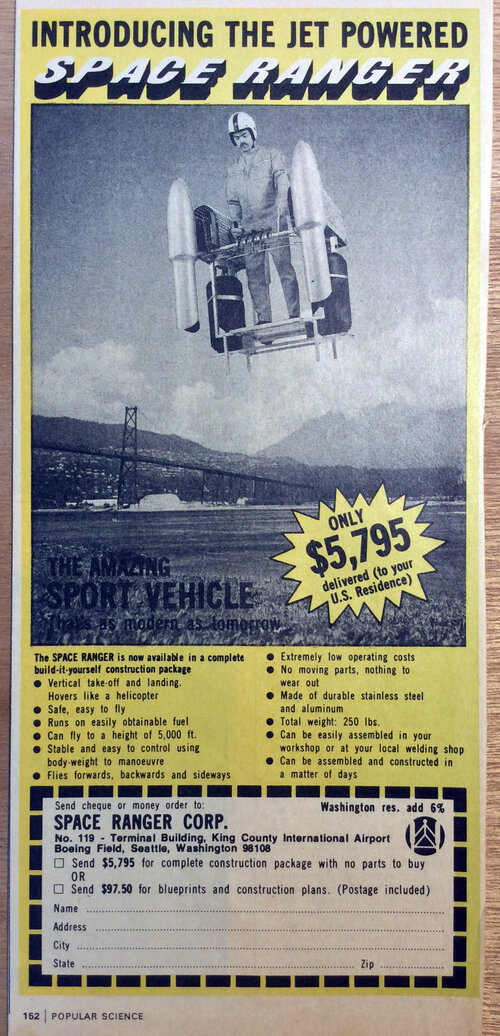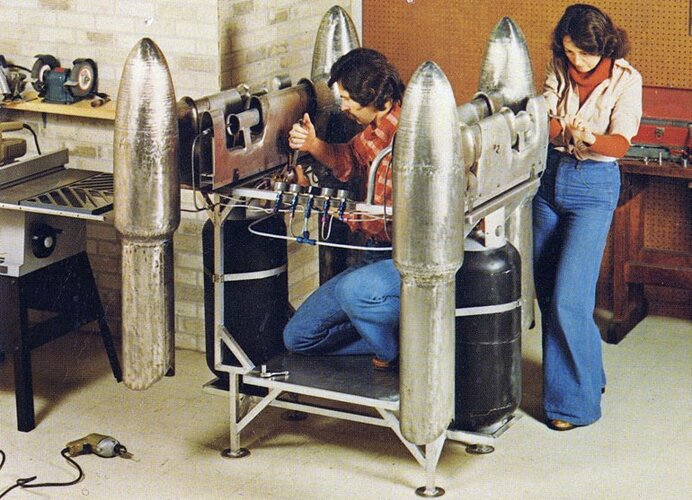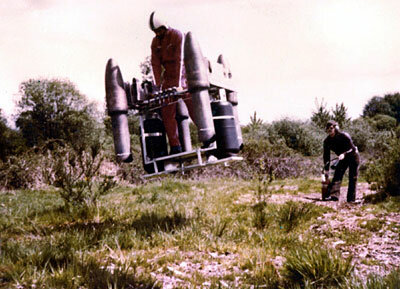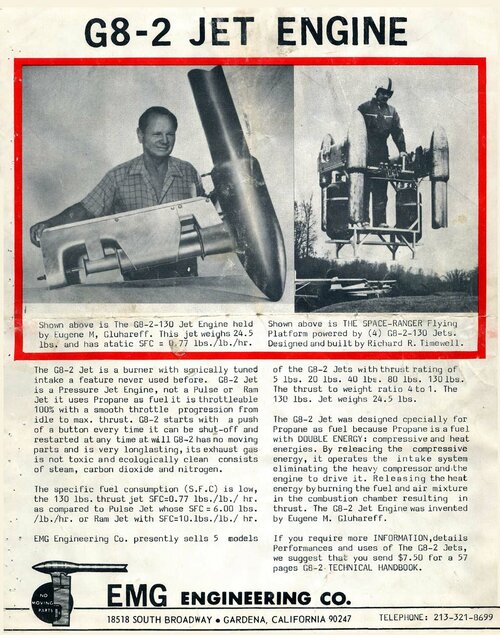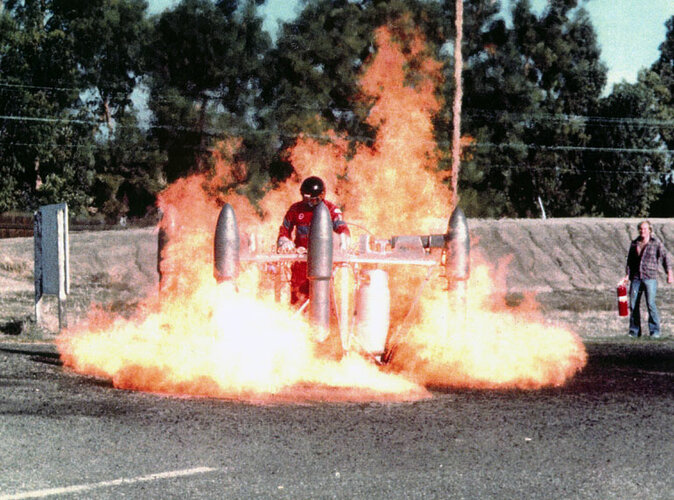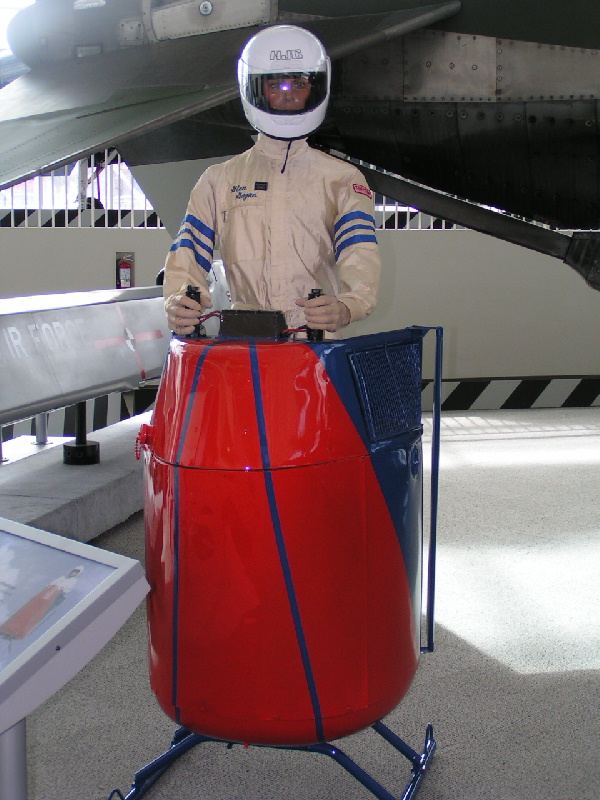Charlesferdinand
amateur theologian
- Joined
- 24 October 2013
- Messages
- 147
- Reaction score
- 208
As there doesn’t seem to be an entry for Richard Timewell’s Space Ranger, I give you what I have been able to gather. Like many, I came across the famous ad in Popular Science of 1977-78, and first thought it was a hoax. I was surprised to find it was an actual project, as the Space Ranger is a serious contender for the most dangerous flying vehicle ever built.
Apart from the ad, the main source is a flurry of newspaper articles in 1978, prompted by Richard Timewell’s attempts to market the Space Ranger. Most, if not all, of these seem to be based on a piece by United Press, which was then adapted by various syndicated newspapers. Piecing these together, I have reconstructed the story of the Space Ranger as told by Richard Timewell himself. I haven’t found any independent source to confirm or contradict his version.
He got the idea after seeing a jetpack in a Bond movie (which must be Thunderball), but he was disappointed with the performance of the Bell jetpack used. He considered strapping a jet engine to a backpack, but that proved to heavy and too hot. So the next step was a flying platform, powered by four rocket engines fueled by liquid propane. He approached Gluhareff and convinced him to produce a more powerful version for the Space Ranger. This would the be the G8-2-130 for a thrust of 130 lbs. (Timewell must have impressed Eugene Gluhareff, as he advertised his engines with a photo of the Space Ranger)
The next hurdle was legal. Timewell was a Canadian, and in Canada it was forbidden for individuals to sell jet engines and kits for flying vehicles. So he moved to Seattle. In the US this was legal, as long as the craft was marked as experimental and it was built for more that 50% by the purchaser. (Health and safety definitely were different back in the day). He and his wife then poured all his savings in developing the Space Ranger to the tune of 70,000 dollars (in 1977 money). To attract investors, he put the ad in Popular Science. This got him a lot of international attention, from doctors, utility companies, the Swiss police, an Iranian construction firm, Hollywood directors and even a funeral parlour (I can’t help but wonder if they thought it would create more business). The full kit sold at 5.795 dollars (the price of a Ford Falcon at the time) and you could have just the blueprints for 97,50.
Exactly how many he sold, is unclear. In one article he says he has sold just one, while in others he claims that about 50 were being built in the US. The latter figure does include the blueprints, so perhaps he sold just the one kit and the rest were blueprints. He was contacted by a Swiss manufacturer who put in an order for 50, because the European market was estimated at 1.500 a year.
Timewell claims to have made hundreds of flights, for a total of about 30 hours in the air, with the longest flight being five minutes and the highest 200 feet. Even so, this is far short of the claimed performance in his publicity campaign, talking about a max height of 5000 feet, a ten mile range and 15 minute flight time.
He did concede that there were some teething troubles. Controls were rudimentary, you simply leaned in the direction you wanted to go. This led to a risk of hitting obstacles like trees, and Richard Timewell’s brother cracked a rib in a landing accident. Also, the rocket exhaust could start fires on the ground.
The engine controls also needed finetuning. The cooling effect of the expanding propane could cause the throttle and the fuel lines to freeze up. Sometimes one of the engines didn’t fire, and vented unburned propane instead, which was then ignited by the exhaust of the other engines. But, as Timewell said, you eyebrows will grow back. He was safety conscious, in a way, because he told the next version would have a roll bar and parachute that could deploy in less than a second.
Then there was the noise and the vibrations, which he described as shattering. He always wore a helmet with ear protection when flying. During one clandestine test in the backwoods, an unsuspecting hiker came upon the Space Ranger. The deafening noise made him panic and run away, without waiting for an explanation.
After this brief period of attention, Richard Timewell seems to be lost to history. I have found no further references or obituaries, so if he did blow himself up, it passed unnoticed. There is, however one related story.
In 1979 rocket car pilot Ed Ballanger demonstrated his Vertical Lift Monster at the Orange County Speedway in California. He didn’t achieve liftoff and was nearly roasted in the process. The NHRA then threatened him with a lifelong ban on speedways if he ever pulled a stunt like that again. This vehicle clearly is much bigger than the Space Ranger, but is conceptually similar and also powered by four Gluhareff rockets. Was Ed Ballanger perhaps one of the customers mentioned by Timewell, and did he tinker a bit with the design based on his own experiences with rocket cars? He certainly seems to have increased the distance between himself and the rocket engines, which is a smart move.





Apart from the ad, the main source is a flurry of newspaper articles in 1978, prompted by Richard Timewell’s attempts to market the Space Ranger. Most, if not all, of these seem to be based on a piece by United Press, which was then adapted by various syndicated newspapers. Piecing these together, I have reconstructed the story of the Space Ranger as told by Richard Timewell himself. I haven’t found any independent source to confirm or contradict his version.
He got the idea after seeing a jetpack in a Bond movie (which must be Thunderball), but he was disappointed with the performance of the Bell jetpack used. He considered strapping a jet engine to a backpack, but that proved to heavy and too hot. So the next step was a flying platform, powered by four rocket engines fueled by liquid propane. He approached Gluhareff and convinced him to produce a more powerful version for the Space Ranger. This would the be the G8-2-130 for a thrust of 130 lbs. (Timewell must have impressed Eugene Gluhareff, as he advertised his engines with a photo of the Space Ranger)
The next hurdle was legal. Timewell was a Canadian, and in Canada it was forbidden for individuals to sell jet engines and kits for flying vehicles. So he moved to Seattle. In the US this was legal, as long as the craft was marked as experimental and it was built for more that 50% by the purchaser. (Health and safety definitely were different back in the day). He and his wife then poured all his savings in developing the Space Ranger to the tune of 70,000 dollars (in 1977 money). To attract investors, he put the ad in Popular Science. This got him a lot of international attention, from doctors, utility companies, the Swiss police, an Iranian construction firm, Hollywood directors and even a funeral parlour (I can’t help but wonder if they thought it would create more business). The full kit sold at 5.795 dollars (the price of a Ford Falcon at the time) and you could have just the blueprints for 97,50.
Exactly how many he sold, is unclear. In one article he says he has sold just one, while in others he claims that about 50 were being built in the US. The latter figure does include the blueprints, so perhaps he sold just the one kit and the rest were blueprints. He was contacted by a Swiss manufacturer who put in an order for 50, because the European market was estimated at 1.500 a year.
Timewell claims to have made hundreds of flights, for a total of about 30 hours in the air, with the longest flight being five minutes and the highest 200 feet. Even so, this is far short of the claimed performance in his publicity campaign, talking about a max height of 5000 feet, a ten mile range and 15 minute flight time.
He did concede that there were some teething troubles. Controls were rudimentary, you simply leaned in the direction you wanted to go. This led to a risk of hitting obstacles like trees, and Richard Timewell’s brother cracked a rib in a landing accident. Also, the rocket exhaust could start fires on the ground.
The engine controls also needed finetuning. The cooling effect of the expanding propane could cause the throttle and the fuel lines to freeze up. Sometimes one of the engines didn’t fire, and vented unburned propane instead, which was then ignited by the exhaust of the other engines. But, as Timewell said, you eyebrows will grow back. He was safety conscious, in a way, because he told the next version would have a roll bar and parachute that could deploy in less than a second.
Then there was the noise and the vibrations, which he described as shattering. He always wore a helmet with ear protection when flying. During one clandestine test in the backwoods, an unsuspecting hiker came upon the Space Ranger. The deafening noise made him panic and run away, without waiting for an explanation.
After this brief period of attention, Richard Timewell seems to be lost to history. I have found no further references or obituaries, so if he did blow himself up, it passed unnoticed. There is, however one related story.
In 1979 rocket car pilot Ed Ballanger demonstrated his Vertical Lift Monster at the Orange County Speedway in California. He didn’t achieve liftoff and was nearly roasted in the process. The NHRA then threatened him with a lifelong ban on speedways if he ever pulled a stunt like that again. This vehicle clearly is much bigger than the Space Ranger, but is conceptually similar and also powered by four Gluhareff rockets. Was Ed Ballanger perhaps one of the customers mentioned by Timewell, and did he tinker a bit with the design based on his own experiences with rocket cars? He certainly seems to have increased the distance between himself and the rocket engines, which is a smart move.
